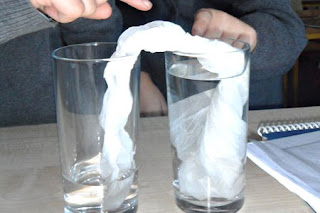Escaping Water
Water will definitely move in mysterious ways in which, get the water from one cup to create its high hill and go into reverse into a second empty cup with the assistance of paper towels and a remarkable scientific method.
Material
A glass of water
An empty glass
Some paper towels
Procedure
Step 1:
Twist one or two of items of towel along till it forms one thing that appearsto a small degree sort of a piece of rope, this can be the 'wick' which will absorb and transfer the water .
Step 2:
Place one finish of the paper towels into the glass crammed withwater and also the alternative into the empty glass.
Step 3:
Your towel rope starts obtaining wet, once a couple of minutes you'll notice that the empty glass is getting down to fill with water, it keeps filling till there's an excellent quantity of water in every glass, however will this happen?
Conclusion :
This method is named 'capillary action', the water uses this method to maneuveron the small gaps within the fibre of the paper towels.
It happens attributable to the adhesive force between the water and also thetowel being stronger than the cohesive forces within the water itself.
This method may also be seen in plants wherever wet travels from the roots to the remainder of the plant.
The same experiment can be done using food color Also:
Watch this video


























